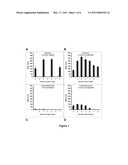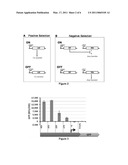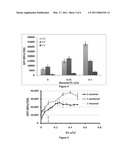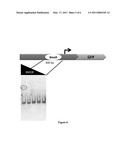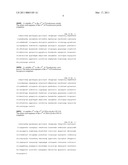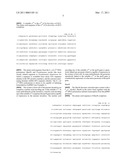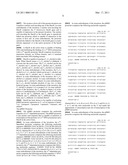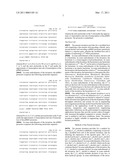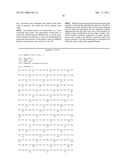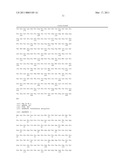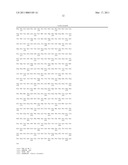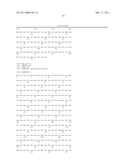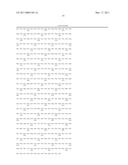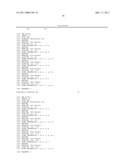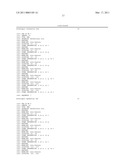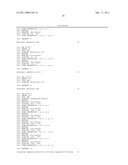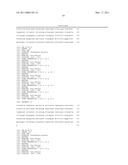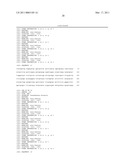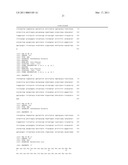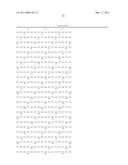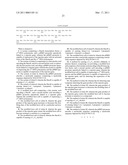Patent application title: Novel transcription factor-based biosensor
Inventors:
Jeffrey A. Dietrich (San Francisco, CA, US)
Jay D. Keasling (Berkeley, CA, US)
Assignees:
THE REGENTS OF THE UNIVERSITY OF CALIFORNIA
IPC8 Class: AC12Q168FI
USPC Class:
435 6
Class name: Chemistry: molecular biology and microbiology measuring or testing process involving enzymes or micro-organisms; composition or test strip therefore; processes of forming such composition or test strip involving nucleic acid
Publication date: 2011-03-17
Patent application number: 20110065105
Claims:
1. A system comprising a BmoR transcription factor, a σ54-RNA
polymerase, and a pBMO promoter operatively linked to a reporter gene,
wherein the pBMO promoter is capable of expression of the reporter gene
with an activated form of the BmoR and the σ54-RNA polymerase.
2. The system of claim 1 comprising (a) a first nucleic acid encoding the BmoR, and (b) a second nucleic acid, or optionally the first nucleic acid, encoding a pBMO promoter operatively linked to a reporter gene; wherein the system is capable of expressing the σ54-RNA polymerase and the pBMO promoter is capable of expression of the reporter gene.
3. The system of claim 2, wherein the pBMO promoter encodes a nucleotide sequence comprising a nucleotide sequence depicted by SEQ ID NO:5-16.
4. The system of claim 1, wherein the BmoR is capable of sensing a C2-C8 alcohol.
5. The system of claim 4, wherein the BmoR is capable of sensing butan-1-ol, 1-propanol, 2-propanol, 1-pentanol, 1-hexanol, or ethanol.
6. A modified host cell comprising a first nucleic acid encoding a BmoR1, and a second nucleic acid encoding a pBMO promoter operatively linked to a reporter gene, wherein the modified host cell is capable of expressing a σ54-RNA polymerase.
7. The modified host cell of claim 6, wherein the gene product of the reporter gene increases or decreases the doubling time of the modified host cell in a particular environment.
8. The modified host cell of claim 6, wherein the gene product of the reporter gene causes the modified host cell to become resistant or sensitive to a compound.
9. The modified host cell of claim 6, wherein the BmoR is capable of sensing a C2-C8 alcohol.
10. The modified host cell of claim 9, wherein the BmoR is capable of sensing butan-1-ol, 1-propanol, 2-propanol, 1-pentanol, 1-hexanol, or ethanol.
11. The modified host cell of claim 6, wherein the pBMO promoter encodes a nucleotide sequence comprising a nucleotide sequence depicted by SEQ ID NO:5-16.
12. A method for sensing a C2-C8 alcohol, aldehyde, or mixture thereof, comprising: (a) providing a modified host cell comprises a first nucleic acid encoding a BmoR transcription factor, and a second nucleic acid encoding a pBMO promoter operatively linked to a reporter gene, wherein the modified host cell is capable of expressing a σ54-RNA polymerase and the pBMO promoter is capable of expression of the reporter gene, and (b) detecting the expression of the reporter gene.
13. The method of claim 12, wherein the (b) detecting step comprises detecting the gene product of the reporter gene.
14. The method of claim 13, wherein the gene product of the reporter gene increases or decreases the doubling time of the modified host cell.
15. The method of claim 13, wherein the gene product of the reporter gene causes the modified host cell to become resistant or sensitive to a compound.
16. The method of claim 12, wherein the BmoR is capable of sensing a C2-C8 alcohol.
17. The method of claim 16, wherein the BmoR is capable of sensing butan-1-ol, 1-propanol, 2-propanol, 1-pentanol, 1-hexanol, or ethanol.
18. The method of claim 12, wherein the pBMO promoter encodes a nucleotide sequence comprising a nucleotide sequence depicted by SEQ ID NO:5-16.
Description:
RELATED PATENT APPLICATIONS
[0001]The application claims priority to U.S. Provisional Patent Application Ser. No. 61/172,678, filed Apr. 24, 2009, which is herein incorporated by reference in its entirety.
FIELD OF THE INVENTION
[0003]This invention relates generally to a transcription factor-based biosensor.
BACKGROUND OF THE INVENTION
[0004]In vivo biosensors for small molecules remain a valuable means through which one can design regulatory networks, build screens/selections, and quantify in vivo concentrations of metabolites of interest following system perturbations. Transcription activator and repressor proteins--proteins that modulate the activity of the RNA polymerase on a given promoter--serve as perhaps the most straight forward and controllable option for an in vivo biosensor. Further, transcription repressor/activator proteins are numerous in nature and there exist a wide range of low molecular weight ligands to which they respond. The value of an in vivo biosensor is intrinsically founded upon its transcription profile. An ideal in vivo biosensor would possess little-to-no basal level of expression in the absence of an input signal and the output signal would be linear over a large dynamic range.
[0005]Putatively, σ54-dependent promoters and their associated activator proteins are ideally suited for use as in vivo biosensors. The sigma subunits of RNA polymerase specifically bind to DNA sequence elements and are responsible for differential gene expression. The primary, and most well understood, sigma factor is σ70. σ70 associates with the core RNA polymerase (E) to transcribe housekeeping genes. The complex E-σ70 alone can be sufficient to catalyze the open promoter complex and allow RNA transcription. While activity can be controlled by various repressor proteins, leaky expression persists.
[0006]Absolute control, however, is accomplished through the use the much less common complex E-σ54. While most bacteria contain several alternative σ factors of the σ70 class, usually only one σ54 form exists. A σ54-governed promoter is unique in that hydrolysis of the promoter DNA by an activator protein is an absolute requisite for transcription, imparting an intrinsically very low level of basal expression. ATP hydrolysis by activator proteins can be triggered by phosphorylation, binding of low molecular weight ligands, or protein-protein interaction. Further, without the need for a repressor protein, transcription levels can be tightly controlled over a large dynamic range. Lastly, the σ54-based transcription system is a dedicated transcription system with little cross-talk; there exist close to 100 σ54 molecules of in E. coli (compared to 700 of σ70), while there are only 20 σ54-governed promoters.
[0007]Use of σ54-dependent promoters and their cognate activator proteins as biosensors in E. coli has been limited to date. Most of the 20 native E. coli σ54-dependent promoters are induced in response to nitrogen limitation, potentially minimizing their use in biotechnology applications; however, prpBCDE promoters from Salmonella enteric serovar Typhimurium and E. coli have been explored by Lee, et al. as a propionate-inducible expression system (Lee, S. K., Keasling, J. D. A Propionate-Inducible Expression System for Enteric Bacteria. Appl. Environ. Microbiol. 71, 6856-6862 (2005)).
SUMMARY OF THE INVENTION
[0008]The present invention provides for a system comprising a BmoR transcription factor, a σ54-RNA polymerase, and a pBMO promoter operatively linked to a reporter gene, wherein the pBMO promoter is capable of expression of the reporter gene with an activated form of the BmoR and the σ54-RNA polymerase.
[0009]The present invention provides for a system comprising a first nucleic acid encoding a BmoR, and a second nucleic acid encoding a pBMO promoter operatively linked to a reporter gene, wherein the system is capable of expressing a σ54-RNA polymerase and the pBMO promoter is capable of expression of the reporter gene.
[0010]The present invention provides for a modified host cell comprising a first nucleic acid encoding a BmoR, and a second nucleic acid encoding a pBMO promoter operatively linked to a reporter gene, wherein the modified host cell is capable of expressing a σ54-RNA polymerase.
[0011]The present invention provides for an isolated or purified or recombinant BmoR. In some embodiments, the BmoR is bound to a DNA.
[0012]The present invention provides for a method for sensing a C2-C8 alcohol, aldehyde, or mixture thereof, comprising: (a) providing a modified host cell of the present invention, and (b) detecting the expression of the reporter gene.
[0013]In some embodiments of the invention, the (b) detecting step comprises detecting the gene product of the reporter gene. In some embodiments of the invention, the gene product of the reporter gene increases or decreases the doubling time of the modified host cell. In some embodiments of the invention, the gene product of the reporter gene causes the modified host cell to become resistant or sensitive to a compound.
BRIEF DESCRIPTION OF THE DRAWINGS
[0014]The foregoing aspects and others will be readily appreciated by the skilled artisan from the following description of illustrative embodiments when read in conjunction with the accompanying drawings.
[0015]FIG. 1 shows the induction of β-galactosidase activity in a P. butanova lacZ reporter strain (X::lacZ) in which the bmo promoter controls the expression of a lacZ reporter cassette (Panels A and B), and in a mutant R8-X::lacZ reporter strain in which bmoR is insertionally inactivated (Panels C and D). (Panels A and C) Induction of β-galactosidase in X::lacZ (Panel A) and in mutant R8-X::lacZ (Panel C) in response to alcohols (C2-C8) following growth on lactate. (Panels B and D) Induction of β-galactosidase in X::lacZ (Panel B) and in mutant R8-X::lacZ (Panel D) in response to alcohols (C2-C8) following growth on propionate. (See Kurth, E. G., Doughty, D. M., Bottomley, P. J., Arp, D. J. & Sayavedra-Soto, L. A. Involvement of BmoR and BmoG in n-alkane metabolism in `Pseudomonas butanovora`. Microbiology 154, 139-147 (2008).)
[0016]FIG. 2 shows an example of a positive selection (Panel A) and a negative selection (Panel B) constructs.
[0017]FIG. 3 shows the transcriptional expression from various pBMO::GFP (green fluorescence protein) constructs which vary in the length of upstream region of pBMO in response to butan-1-ol.
[0018]FIG. 4 shows the transcriptional expression from a pBMO::GFP construct when host cells are cultured in different concentrations of butan-1-ol and different temperatures.
[0019]FIG. 5 shows the transcriptional expression from a pBMO::GFP construct in response to varying amounts of butan-1-ol, 1-pentanol, and 1-hexanol.
[0020]FIG. 6 shows the transcriptional expression from a pBMO::GFP construct in response to varying amounts of ethanol, 1-propanol, and 2-propanol.
[0021]FIG. 7 shows the isolation of His-tagged BmoR. The arrow indicates the band corresponding to isolated BmoR.
[0022]FIG. 8 shows the characterization of the BmoR DNA-binding site on the pBMO promoter. The oval on the gel indicates the shifted band indicating the binding of BmoR.
[0023]FIG. 9 shows the E. coli specific growth rates in varying concentrations of tetracycline and butanol. E. coli cultures harboring the butanol biosensor controlling TetA expression are inoculated into media containing multiple concentrations of butanol and tetracycline.
[0024]FIG. 10 shows the tetracycline concentration at which half maximal growth inhibition (IC50) can be correlated to butanol concentration, ts, and tf.
DETAILED DESCRIPTION
[0025]Before the present invention is described, it is to be understood that this invention is not limited to particular embodiments described, as such may, of course, vary. It is also to be understood that the terminology used herein is for the purpose of describing particular embodiments only, and is not intended to be limiting, since the scope of the present invention will be limited only by the appended claims.
[0026]Where a range of values is provided, it is understood that each intervening value, to the tenth of the unit of the lower limit unless the context clearly dictates otherwise, between the upper and lower limits of that range is also specifically disclosed. Each smaller range between any stated value or intervening value in a stated range and any other stated or intervening value in that stated range is encompassed within the invention. The upper and lower limits of these smaller ranges may independently be included or excluded in the range, and each range where either, neither or both limits are included in the smaller ranges is also encompassed within the invention, subject to any specifically excluded limit in the stated range. Where the stated range includes one or both of the limits, ranges excluding either or both of those included limits are also included in the invention.
[0027]Unless defined otherwise, all technical and scientific terms used herein have the same meaning as commonly understood by one of ordinary skill in the art to which this invention belongs. Although any methods and materials similar or equivalent to those described herein can be used in the practice or testing of the present invention, the preferred methods and materials are now described. All publications mentioned herein are incorporated herein by reference to disclose and describe the methods and/or materials in connection with which the publications are cited.
[0028]It must be noted that as used herein and in the appended claims, the singular forms "a", "and", and "the" include plural referents unless the context clearly dictates otherwise. Thus, for example, reference to "a carboxylic acid" includes a plurality of such carboxylic acids, and so forth.
[0029]In this specification and in the claims that follow, reference will be made to a number of terms that shall be defined to have the following meanings:
[0030]The terms "expression vector" or "vector" refer to a compound and/or composition that can be introduced into a host cell by any suitable method, including but not limited to transduction, transformation, transfection, infection, electroporation, conjugation, and the like; thereby causing the cell to express nucleic acids and/or proteins other than those native to the cell, or in a manner not native to the cell. An "expression vector" contains a sequence of nucleic acids (ordinarily RNA or DNA) to be expressed by the host cell. Optionally, the expression vector also comprises materials to aid in achieving entry of the nucleic acid into the host cell, such as a virus, liposome, protein coating, or the like. The expression vectors contemplated for use in the present invention include those into which a nucleic acid sequence can be inserted, along with any preferred or required operational elements. Further, the expression vector must be one that can be transferred into a host cell and replicated therein. Particular expression vectors are plasmids, particularly those with restriction sites that have been well documented and that contain the operational elements preferred or required for transcription of the nucleic acid sequence. Such plasmids, as well as other expression vectors, are well known to those of ordinary skill in the art.
[0031]The term "isolated" refers to material that is substantially or essentially free of components that normally accompany it in its native state.
[0032]As used herein, the terms "nucleic acid", "nucleotide" and variations thereof shall be generic to polydeoxyribonucleotides (containing 2-deoxy-D-ribose), to polyribonucleotides (containing D-ribose), to any other type of polynucleotide that is an N-glycoside of a purine or pyrimidine base, and to other polymers containing normucleotidic backbones, provided that the polymers contain nucleobases in a configuration that allows for base pairing and base stacking, as found in DNA and RNA.
[0033]The term "operably linked" refers to a functional linkage between a nucleic acid expression control sequence (such as a promoter) and a second nucleic acid sequence, wherein the expression control sequence directs transcription of the nucleic acid corresponding to the second sequence.
[0034]These and other objects, advantages, and features of the invention will become apparent to those persons skilled in the art upon reading the details of the invention as more fully described below.
[0035]The present invention provides for a method for evolving and screening/selecting microorganisms producing an intracellular metabolite of interest. This invention is based on design and construction of biosensors, composed of transcription factors and their cognate promoters, capable of binding an intracellular small molecule of interest. The presence of the small molecule of interest causes the transcription factor to modulate expression of the cognate promoter. The output of the promoter provides a means for screening or selecting for microorganisms producing the small molecule of interest. In specific, this invention involves a σ54-dependent transcription factor and its cognate promoters. This class of transcription factors has been shown to bind to a broad range of industrial and commercial small molecules of interest. The small molecule of interest is a C2-C8 alcohol or aldehyde.
[0036]The screen/selection can be used to evolve microorganisms capable of producing increased amounts of the small molecule. Accurate, high throughput detection of intracellular metabolites remains a difficult task in biotechnology. Currently, low throughput chromatography methods are the gold standard in metabolite detection. The present invention provides a high throughput means to screen host cells or microorganisms, improving throughput by several orders of magnitude. In some embodiments, implementation of the present invention as a selection allows for direct, dynamic evolution of strains without the need for selections.
[0037]The present invention provides for a system comprising a BmoR, a σ54-RNA polymerase, and a pBMO promoter operatively linked to a reporter gene, wherein the pBMO promoter is capable of expression of the reporter gene with an activated for of the BmoR and the σ54-RNA polymerase.
[0038]The present invention provides for a system comprising a first nucleic acid encoding a BmoR, and a second nucleic acid encoding a pBMO promoter operatively linked to a reporter gene, wherein the system is capable of expressing a σ54-RNA polymerase and the pBMO promoter is capable of expression of the reporter gene.
[0039]In some embodiments, the system is an in vitro system wherein all of the necessary components for transcription of the reporter gene, including but not limited to any necessary cofactors and nucleotide triphosphates, are present in the system.
[0040]In some embodiments, the system is an in vivo system wherein all of the necessary components for transcription of the reporter gene are present within a host cell.
[0041]In some embodiments of the present invention, the first nucleic acid and the second nucleic acid are each independently on a vector or integrated into a chromosome. The vector can be an expression vector or a plasmid. In some embodiments of the present invention, the vector is capable of stable maintenance in a host cell.
[0042]In some embodiments of the present invention, the first nucleic acid and the second nucleic acid are on a vector, such as a plasmid.
[0043]The nucleic acid that encodes the peptides of interest, such as BmoR, sigma 54, pBMO promoter-linked reporter gene of the present invention. The recombinant nucleic acid can be a double-stranded or single-stranded DNA, or RNA. The recombinant nucleic acid can encode an open reading frame (ORF) of BmoR, sigma 54, pBMO promoter-linked reporter gene. The recombinant nucleic acid can also comprise promoter sequences for transcribing the ORF in a suitable host cell. The recombinant nucleic acid can also comprise sequences sufficient for having the recombinant nucleic acid stably replicate in the host cell. The recombinant nucleic acid can be replicon capable of stable maintenance in a host cell. In some embodiments, the replicon is a plasmid. The present invention also provides for a vector or expression vector comprising a recombinant nucleic acid of the present invention.
[0044]It will be apparent to one of skill in the art that a variety of recombinant vectors can be utilized in the practice of aspects of the invention. As used herein, "vector" refers to polynucleotide elements that are used to introduce recombinant nucleic acid into cells for either expression or replication. Selection and use of such vehicles is routine in the art. An "expression vector" includes vectors capable of expressing DNAs that are operatively linked with regulatory sequences, such as promoter regions. Thus, an expression vector refers to a recombinant DNA or RNA construct, such as a plasmid, a phage, recombinant virus or other vector that, upon introduction into an appropriate host cell, results in expression of the cloned DNA. Appropriate expression vectors are well known to those of skill in the art and include those that are replicable in the host cells and those that remain episomal or those that integrate into the host cell genome.
[0045]The vectors may be chosen to contain control sequences operably linked to the resulting coding sequences in a manner that expression of the coding sequences may be effected in an appropriate host cell. Suitable control sequences include those that function in the host cells. If the cloning vectors employed to obtain encoded peptides of interest lack control sequences for expression operably linked to the encoding nucleotide sequences, the nucleotide sequences are inserted into appropriate expression vectors. This can be done individually, or using a pool of isolated encoding nucleotide sequences, which can be inserted into host vectors, the resulting vectors transformed or transfected into host cells, and the resulting cells plated out into individual colonies. Suitable control sequences for single cell cultures of various types of organisms are well known in the art. Control systems for expression in yeast are widely available and are routinely used. Control elements include promoters, optionally containing operator sequences, and other elements depending on the nature of the host, such as ribosome binding sites. Particularly useful promoters for prokaryotic host cells include those promoters that are native to the peptide of interest. However, other bacterial promoters, such as those derived from sugar metabolizing enzymes, such as galactose, lactose (lac) and maltose, are also useful. Additional examples include promoters derived from biosynthetic enzymes such as for tryptophan (trp), the β-lactamase (bla), bacteriophage lambda PL, and T5. In addition, synthetic promoters, such as the tac promoter (U.S. Pat. No. 4,551,433; hereby incorporated by reference), can be used.
[0046]Selectable markers can also be included in the recombinant expression vectors with the proviso that the selectable markers are not the reporter gene. A variety of markers are known which are useful in selecting for transformed cell lines and generally comprise a gene whose expression confers a selectable phenotype on transformed cells when the cells are grown in an appropriate selective medium. Such markers include, for example, genes that confer antibiotic resistance or sensitivity to the plasmid.
[0047]The nucleic acid sequences or nucleotide sequences described herein, or a mixture of such sequences, can be cloned into one or more recombinant vectors as individual cassettes, with separate control elements or under the control of a single promoter. Methods for introducing the recombinant vectors of the present invention into suitable hosts are known to those of skill in the art and typically include the use of CaCl2 or other agents, such as divalent cations, lipofection, DMSO, protoplast transformation, conjugation, and electroporation.
Sigma 54 (σ54)
[0048]The system comprises a σ54 or has the capability of expressing σ54. Any σ54 can be used that can be used to initiate transcription from the pBMO promoter.
[0049]A suitable σ54 is the σ54 of Pseudomonas putida. The amino acid sequence of the σ54 of Pseudomonas putida comprises:
TABLE-US-00001 (SEQ ID NO: 1) 1 mkpslvlkmg qqltmtpqlq qairllqlst ldlqqeiqea lesnpmlerq edgedfdnsd 61 pmadnaenkp aaevqdnsfq estvsadnle dgewseripn elpvdtawed iyqtsasslp 121 sndddewdft trtsageslq shllwqlnla pmsdtdrlia vtlidsingq gyledtleei 181 sagfdpeldi eldeveavlh riqqfepagv garnlgecll lqlrqlpatt pwmteakrlv 241 tdfidllgsr dysqlmrrmk ikedelrqvi elvqslnprp gsqiessepe yvvpdvivrk 301 dsdrwlveln qeaiprlrvn pqyagfvrra dtsadntfmr nqlqearwfi kslqsrnetl 361 mkvatriveh qrgfldhgde amkplvlhdi aeavgmhest isrvttqkym htprgiyelk 421 yffsshvsts eggecsstai raiikklvaa enqkkplsds kiaglleaqg iqvarrtvak 481 yreslgiaps serkrlm
[0050]A suitable σ54 is the σ54 of Pseudomonas aerogenosa. The amino acid sequence of the σ54 of Pseudomonas aerogenosa comprises:
TABLE-US-00002 (SEQ ID NO: 2) 1 mkpslvlkmg qqltmtpqlq qairllqlst ldlqqeiqea lesnpmlerq edgddfdnsd 61 pladgaeqaa sapqesplqe satpsvesld ddqwserips elpvdtawed iyqtsasslp 121 sndddewdft artssgeslh shllwqvnla pmsdtdrmia vtiidsinnd gyleesleei 181 laaidpeldv eldevevvlr riqqlepagi garnlrecll lqlrqlpstt pwlnealrlv 241 sdyldllggr dysqlmrrmk lkedelrqvi eliqclhprp gsqiesseae yivpdvivrk 301 dnerwlveln qeamprlrvn atyagmvrra dssadntfmr nqlqearwfi ktlqsrnetl 361 mkvatqiveh qrgfldygee amkplvlhdi aeavgmhest isrvttqkym htprgifelk 421 yffsshvsta eggecsstai raiikklvaa enakkplsds kiaglleaqg iqvarrtvak 481 yreslgiaps serkrlv
[0051]A suitable σ54 is the σ54 of Vibrio fischeri ES 114. The amino acid sequence of the σ54 of Vibrio fischeri ES114 comprises:
TABLE-US-00003 (SEQ ID NO: 3) 1 mkaslqlkmg qqlamtpqlq qairllqlst ldlqqeiqea ldsnplldve eealstpetl 61 tspepkseke tasaeqetpi tdssdviesn niseelemda swddvysans gstglaiddd 121 tpiyqgette slqdylmwqa dltpftdldr tiattiiesl deygyltssl ddilesigde 181 evemdeveav lkriqqfdpl gvasrdlaec lllqlatypa ntpwlpetkl ilkdhinllg 241 nrdyrqlake tklkesdlkq vmmliheldp rpgnrvidte teyvipdvsv fkhngkwvvt 301 inpdsvprlk vnaeyaalgk tmgntpdgqf irtnlqeakw likslesrne tllkvarciv 361 ehqqdffeyg eeamkpmvin dialdvdmhe stisrvttqk fmhtprgife lkyffsshvs 421 tdnggecsst airalvkklv aaenqakpls dskiatllae qgiqvarrti akyreslgia 481 psnqrkrll
[0052]A suitable σ54 is the σ54 of Escherichia coli K12. The amino acid sequence of the σ54 of Escherichia coli K12 comprises:
TABLE-US-00004 (SEQ ID NO: 3) 1 mkqglqlrls qqlamtpqlq qairllqlst lelqqelqqa lesnplleqi dtheeidtre 61 tqdsetldta daleqkempe elpldaswdt iytagtpsgt sgdyiddelp vyqgettqtl 121 qdylmwqvel tpfsdtdrai atsivdavde tgyltvpled ilesigdeei dideveavlk 181 riqrfdpvgv aakdlrdcll iqlsqfdktt pwleearlii sdhldllanh dfrtlmrvtr 241 lkedvlkeav nliqsldprp gqsiqtgepe yvipdvlvrk hnghwtveln sdsiprlqin 301 qhyasmcnna rndgdsqfir snlqdakwli kslesrndtl lrvsrciveq qqaffeqgee 361 ymkpmvladi aqavemhest isrvttqkyl hsprgifelk yffsshvnte gggeasstai 421 ralvkkliaa enpakplsds kltsllseqg imvarrtvak yreslsipps nqrkqlv
[0053]The amino acid sequence from the E. coli σ54 RNA polymerase (RpoN) and Pseudomonas putida (the most closely related organism to Pseudomonas butanovora for which a sequence is available) have about 52% sequence identity (with 70% positive matches), and the activator interacting domains exhibit 86% sequence identity. The E. coli σ54-RNA polymerase is shown to be capable of initiating transcription of pBMO (see Example 1).
[0054]The system or host cell of the present invention can comprise a nucleic acid encoding any of the suitable σ54. In some embodiments of the invention, a nucleic acid encoding any of the suitable σ54 comprises the rpoN gene and is capable of expression in the present invention. The nucleic acid encoding any of the suitable σ54 or the rpoN gene is operatively linked any promoter which is capable of expression in the system or host cell. In some embodiments, the promoter operatively linked to the suitable σ54 or the rpoN gene is constitutively expressed, or is the native promoter of the rpoN gene.
BmoR
[0055]The BmoR becomes activated upon contact with a C2-Cs alcohol. BmoR in the active form together with the σ54-RNA polymerase initiates transcription from the pBMO promoter.
[0056]The amino acid sequence of BmoR comprises:
TABLE-US-00005 (SEQ ID NO: 4) 1 mskmqefarl etvasmrrav wdgnecqpgk vadvvlrswt rcraegvvpn arqefdpipr 61 taldetveak ralilaaepv vdalmeqmnd aprmiilnde rgvvllnqgn dtlledarrr 121 avrvgvcwde hargtnamgt alaerrpvai hgaehylesn tiftctaapi ydpfgeftgi 181 ldisgyagdm gpvpipfvqm avqfienqlf rqtfadcill hfhvrpdfvg tmregiavls 241 regtivsmnr aglkiaglnl eavadhrfds vfdlnfgafl dhvrqsafgl vrvslyggvq 301 vyarvepglr vpprpaahar pprpaprpld sldtgdaavr laidrarrai grnlsiliqg 361 etgagkevfa khlhaesprs kgpfvavnca aipegliese lfgyeegaft ggrrkgnigk 421 vaqahggtlf ldeigdmapg lqtrllrvlq dravmplggr epmpvdialv cathrnlrsl 481 iaqgqfredl yyrlnglais 1pplrqrsdl aalvnhilfq ccggephysv spevmtlfkr 541 hawpgnlrql hnvldaalam lddghvieph hlpedfvmev dsglrpieed gstaahrarq 601 pasgsgpakk lqdlaldaie qaieqnegni svaarqlgvs rttiyrklrq lsptgchrpa 661 hwsqsrigt
[0057]The system or host cell of the present invention can comprise a nucleic acid encoding any of the BmoR. In some embodiments of the invention, a nucleic acid encoding the BmoR comprises the P. butanovora bmoR gene and is capable of expression in the present invention. The nucleic acid encoding the BmoR or the bmoR gene is operatively linked any promoter which is capable of expression in the system or host cell. In some embodiments, the promoter operatively linked to the BmoR or the bomR gene is constitutively expressed, or is the native promoter of the bmoR gene.
[0058]A BmoR in the active form is capable of binding DNA and facilitating the binding of a σ54-RNA polymerase with a σ54-specific promoter. BmoR comprises an activator-interaction domain, an ATPase domain, and a C-terminal helix-turn-helix DNA-binding domain.
[0059]BmoR is capable of sensing a C2-C8 alcohol or aldehyde. When BmoR senses a C2-C8 alcohol or aldehyde, it converts into the active form. The C2-C8 alcohol can be any C2 alcohol, any C3 alcohol, any C4 alcohol, any C5 alcohol, any C6 alcohol, any C7 alcohol, any C8 alcohol, or a mixture thereof. In some embodiments of the invention, the C2-C8 alcohol is a C2-C5 alcohol, which can be any C2 alcohol, any C3 alcohol, any C4 alcohol, any C5 alcohol, or a mixture thereof. In some embodiments of the invention, the C2-C5 alcohol is a primary alcohol. In some embodiments of the invention, the C2 alcohol is ethanol. In some embodiments, the C2-C8 alcohol includes alcohols of one, two, or three hydroxyl groups. In some embodiments of the invention, the C3 alcohol is propan-1-ol or propan-2-ol. In some embodiments of the invention, the C4 alcohol is butan-1-ol (n-butanol) or 2-methylpropan-1-ol (isobutanol). The C2-C8 aldehyde can be any C2 aldehyde, any C3 aldehyde, any C4 aldehyde, any C5 aldehyde, any C6 aldehyde, any C7 aldehyde, any C8 aldehyde, or a mixture thereof.
[0060]BmoR has been shown to be capable of activating pBMO-promoter expression in E. coli in response to butan-1-ol, 1-propanol, 2-propanol, 1-pentanol, 1-hexanol, and ethanol.
The pBMO Promoter
[0061]The pBMO promoter comprises the nucleotide sequence of a σ54-dependent promoter. The pBMO promoter is any nucleic acid sequence that is capable of initiation of transcription in the presence of a σ54-RNA polymerase and a BmoR in the active form.
[0062]In some embodiments of the invention, the σ54-dependent promoter comprises the following nucleotide sequence: MRNNN TGGCACRN N3 TTGCW NN (SEQ ID NO:5) or MRNNN TGGCACRN N4 TTGCW NN (SEQ ID NO:6), wherein M is C or A; R is A or G; W is A or T; and N is A, G, C or T. In some embodiments of the invention, the σ54-dependent promoter comprises the following nucleotide sequence: MRNRY TGGCACGN N3 TTGCW NN (SEQ ID NO:7) or MRNRY TGGCACGN N4 TTGCW NN (SEQ ID NO:8), wherein M is C or A; R is A or G; Y is C or T; W is A or T; and N is A, G, C or T. In some embodiments of the invention, the σ54-dependent promoter comprises the following nucleotide sequence: AANNN TGGCACAG NNNN TTGCA TATT (SEQ ID NO:9), wherein N is A, G, C or T. In some embodiments of the invention, the σ54-dependent promoter comprises the following nucleotide sequence: CATGC TGGCACGA CAC TTGCT GAA (SEQ ID NO:10).
[0063]In some embodiments of the invention, the pBMO promoter comprises the following nucleotide sequence:
TABLE-US-00006 (SEQ ID NO: 11) ccacagatag taggtgctgc ggctgctcat gctcctgtcg cggtagcgcg ctgttacgcg accgcccccg gacctcggcg gacagcgcgg aagattggaa acagcccgag cgtgcgtgcc tcgggctgca tccttgccac acccaaccgg attcgtcgga ccgctcgaca ttcgcgttcg ctcccgcggc gccgcgggtg taccgttgcg ttacagatgt acccttcttt aacgtgtaac acacgcctgg agcggccaag agccccgcac cttgcggcgc gtcttcccca ggggcccacc ggttgcggcc ttttgctgcg accgtc (MRNNN TGGCACRN N3 TTGCW NN) aagcgttaga g or (SEQ ID NO: 12) ccacagatag taggtgctgc ggctgctcat gctcctgtcg cggtagcgcg ctgttacgcg accgcccccg gacctcggcg gacagcgcgg aagattggaa acagcccgag cgtgcgtgcc tcgggctgca tccttgccac acccaaccgg attcgtcgga ccgctcgaca ttcgcgttcg ctcccgcggc gccgcgggtg taccgttgcg ttacagatgt acccttcttt aacgtgtaac acacgcctgg agcggccaag agccccgcac cttgcggcgc gtcttcccca ggggcccacc ggttgcggcc ttttgctgcg accgtc (MRNNN TGGCACRN N4 TTGCW NN) aagcgttaga g
wherein M is C or A; R is A or G; W is A or T; and N is A, G, C or T, and the next nucleotide on the 3' end marks the approximate +1 transcription start site of transcription of the pBMO promoter.
[0064]In some embodiments of the invention, the pBMO promoter comprises the following nucleotide sequence:
TABLE-US-00007 (SEQ ID NO: 13) ccacagatag taggtgctgc ggctgctcat gctcctgtcg cggtagcgcg ctgttacgcg accgcccccg gacctcggcg gacagcgcgg aagattggaa acagcccgag cgtgcgtgcc tcgggctgca tccttgccac acccaaccgg attcgtcgga ccgctcgaca ttcgcgttcg ctcccgcggc gccgcgggtg taccgttgcg ttacagatgt acccttcttt aacgtgtaac acacgcctgg agcggccaag agccccgcac cttgcggcgc gtcttcccca ggggcccacc ggttgcggcc ttttgctgcg accgtc (MRNRY TGGCACGN N3 TTGCW NN) aagcgttaga g or (SEQ ID NO: 14) ccacagatag taggtgctgc ggctgctcat gctcctgtcg cggtagcgcg ctgttacgcg accgcccccg gacctcggcg gacagcgcgg aagattggaa acagcccgag cgtgcgtgcc tcgggctgca tccttgccac acccaaccgg attcgtcgga ccgctcgaca ttcgcgttcg ctcccgcggc gccgcgggtg taccgttgcg ttacagatgt acccttcttt aacgtgtaac acacgcctgg agcggccaag agccccgcac cttgcggcgc gtcttcccca ggggcccacc ggttgcggcc ttttgctgcg accgtc(MRNRY TGGCACGN N4 TTGCW NN) aagcgttaga g
wherein M is C or A; R is A or G; W is A or T; and N is A, G, C or T, and the next nucleotide on the 3' end marks the approximate +1 transcription start site of transcription of the pBMO promoter.
[0065]In some embodiments of the invention, the pBMO promoter comprises the following nucleotide sequence:
TABLE-US-00008 (SEQ ID NO: 15) ccacagatag taggtgctgc ggctgctcat gctcctgtcg cggtagcgcg ctgttacgcg accgcccccg gacctcggcg gacagcgcgg aagattggaa acagcccgag cgtgcgtgcc tcgggctgca tccttgccac acccaaccgg attcgtcgga ccgctcgaca ttcgcgttcg ctcccgcggc gccgcgggtg taccgttgcg ttacagatgt acccttcttt aacgtgtaac acacgcctgg agcggccaag agccccgcac cttgcggcgc gtcttcccca ggggcccacc ggttgcggcc ttttgctgcg accgtc (AANNN TGGCACAG NNNN TTGCA TATT) aagcgttaga g
wherein N is A, G, C or T, and the next nucleotide on the 3' end marks the approximate +1 transcription start site of transcription of the pBMO promoter.
[0066]In some embodiments of the invention, the pBMO promoter comprises the following nucleotide sequence:
TABLE-US-00009 (SEQ ID NO: 16) ccacagatag taggtgctgc ggctgctcat gctcctgtcg cggtagcgcg ctgttacgcg accgcccccg gacctcggcg gacagcgcgg aagattggaa acagcccgag cgtgcgtgcc tcgggctgca tccttgccac acccaaccgg attcgtcgga ccgctcgaca ttcgcgttcg ctcccgcggc gccgcgggtg taccgttgcg ttacagatgt acccttcttt aacgtgtaac acacgcctgg agcggccaag agccccgcac cttgcggcgc gtcttcccca ggggcccacc ggttgcggcc ttttgctgcg accgtccatg ctggcacgac acttgctgaa agcgttagag
wherein the next nucleotide on the 3' end marks the approximate +1 transcription start site of transcription of the pBMO promoter. The promoter is underlined.
The Host Cell
[0067]The present invention provides for a modified host cell comprising a first nucleic acid encoding a BmoR, and a second nucleic acid encoding a pBMO promoter operatively linked to a reporter gene, wherein the modified host cell is capable of expressing a σ54-RNA polymerase.
[0068]In some embodiments of the invention, the host cell is a bacterium. In some embodiments of the invention, the bacterium is a Gram-negative β-proteobacterium. In some embodiments of the invention, the bacterium is any bacterium that expresses a σ54. The σ54 can be native or heterologous to the bacterium. In some embodiments of the invention, the bacterium is an enteric bacterium. In some embodiments of the invention, the bacterium has a native σ54. In some embodiments of the invention, the bacterium is of the genus Bacillus, Planctomyces, Bradyrhizobium, Rhodobacter, Rhizobium, Myxococcus, Klebsiella, Azotobacter, Escherichia, Salmonella, Pseudomonas, Caulobacter, Chlamydia, Acinetobacter, Sinorhizobium, Enterococcus, Clostridium, and Vibrio. In some embodiments of the invention, the σ54 is native to the host cell. In some embodiments of the invention, the σ54 is heterologous to the host cell, wherein the host cell optionally does not express its native σ54. In some embodiments of the invention, the bacterium is E. coli.
[0069]One embodiment of the present invention is an in vivo biosensor in E. coli for the detection of a C2-C8 alcohol or aldehyde, including but not limited to ethanol to octanol. Such a biosensor has applications in the development of high-throughput selections and screens for use in engineering microorganisms producing alcohol-based biofuel molecules. Included in the applications would be protein, operon, genome, transporter, and organism-level engineering approaches. Selections are the gold-standard in engineering applications because they provide several orders-of-magnitude increased throughput compared to screens; thereby, a user is enabled to test more conditions, faster. The present invention is highly valuable in engineering organisms for biofuels production.
Methods of the Present Invention
[0070]The present invention provides for a method for sensing a C2-C8 alcohol or aldehyde, comprising: (a) providing a modified host cell of the present invention, and (b) detecting the expression of the reporter gene. The C2-C8 alcohol can be any C2 alcohol, any C3 alcohol, any C4 alcohol, any C5 alcohol, any C6 alcohol, any C7 alcohol, any C8 alcohol, or a mixture thereof. In some embodiments of the invention, the C2-C8 alcohol is a C2-C5 alcohol, which can be any C2 alcohol, any C3 alcohol, any C4 alcohol, any C5 alcohol, or a mixture thereof. In some embodiments of the invention, the C2-C5 alcohol is a primary alcohol. In some embodiments of the invention, the C2 alcohol is ethanol. In some embodiments, the C2-C8 alcohol includes alcohols of one, two, or three hydroxyl groups. In some embodiments of the invention, the C3 alcohol is propan-1-ol or propan-2-ol. In some embodiments, the alcohol is butan-1-ol, 1-propanol, 2-propanol, 1-pentanol, 1-hexanol, ethanol, or a mixture thereof. In some embodiments of the invention, the C4 alcohol is butan-1-ol (n-butanol) or 2-methylpropan-1-ol (isobutanol). The C2-C8 aldehyde can be any C2 aldehyde, any C3 aldehyde, any C4 aldehyde, any C5 aldehyde, any C6 aldehyde, any C7 aldehyde, any C8 aldehyde, or a mixture thereof.
[0071]In some embodiments of the invention, the (b) detecting step comprises detecting the gene product of the reporter gene. In some embodiments of the invention, the gene product of the reporter gene increases or decreases the doubling time of the modified host cell. In some embodiments of the invention, the gene product of the reporter gene causes the modified host cell to become resistant or sensitive to a compound.
[0072]The present invention provides for a method for screening or selecting a host cell that produces a C2-C8 alcohol or aldehyde, comprising: (a) providing a modified host cell of the present invention, (b) culturing the host cell, and (c) screening or selecting the host cell based the expression of the reporter gene by the host cell.
[0073]In some embodiments of the present invention, the method for screening or selecting a host cell that produces a C2-C8 alcohol or aldehyde, comprises: (a) providing a plurality of modified host cells of the present invention wherein the modified host cells of different modification are in separate cultures, (b) culturing each separate culture of host cell, (c) screening or selecting the host cell based the expression of the reporter gene by the host cell, and (d) comparing the expression of the reporter genes of the separate cultures. In some embodiments of the present invention, the (d) comprising step comprises identifying one or more cultures, and/or the corresponding host cell, that have an increased expression of the gene product of the reporter gene.
[0074]In some embodiments, the method is a method for selecting a host cell that produces a C2-C8 alcohol or aldehyde, wherein the selection is a positive selection or a negative selection. When the selection is positive selection, the selecting step selects for host cells that have a higher expression of a reporter gene that increases the probability of remaining viable and doubling, and thus have a higher probability of remaining viable and doubling. When the selection is negative selection, the selecting step selects for host cells that have a lower expression of the reporter gene that decreases the probability of remaining viable and doubling, and thus have a higher probability of remaining viable and doubling.
[0075]In one embodiment of the present invention, the method for selecting an E. coli host cell that produces a C2-C8 alcohol or aldehyde comprises: (a) providing a plurality of modified E. coli host cells of the present invention wherein the modified host cells of different modification are in separate cultures, (b) culturing each separate culture of host cell, (c) selecting the host cell based the expression of the reporter gene by the host cell, and (d) comparing the expression of the reporter genes of the separate cultures, wherein the selecting is a positive selecting.
[0076]In another embodiments of the present invention, the method for selecting an E. coli host cell that produces a C2-C8 alcohol or aldehyde comprises: (a) providing a plurality of modified E. coli host cells of the present invention wherein the modified host cells of different modification are in separate cultures, (b) culturing each separate culture of host cell, (c) selecting the host cell based the expression of the reporter gene by the host cell, and (d) comparing the expression of the reporter genes of the separate cultures, wherein the selecting is a negative selecting.
[0077]In some embodiments of the invention, the compound is an antibiotic and the reporter gene is an antibiotic resistance gene which confers resistance to the antibiotic. In some embodiments of the invention, the reporter gene is cat or bla. The reporter gene can be used as a positive selection or as a negative selection. Positive selection occurs when the increased expression of the gene product of the reporter gene increases the probability that the host cell would remain viable and complete doubling. Examples of reporter genes that confer positive selection are antibiotic resistance genes that confer resistance to an antibiotic of the host cell when the host cell is cultured or grown in a culture containing the antibiotic. An example of such as is a β-lactamase, encoded by the bla gene. Other examples of reporter genes that confer positive selection are genes encoding enzymes that are required by the host cell to metabolize a specific nutrient source which is required by the host cell in order to remain viable and double. Negative selection occurs when the increased expression of the gene product of the reporter gene decreases the probability that the host cell would remain viable and complete doubling. Examples of reporter genes that confer negative selection are genes which when expressed inhibit resistance to an antibiotic of the host cell when the host cell is cultured or grown in a culture containing the antibiotic. An example of such as inhibitor is a β-lactamase inhibitor, such as clavulanic acid, which inhibits a β-lactamase, such as ampicillin.
[0078]A putative σ54-governed promoter (pBMO) was first described in the n-alkane metabolizing microbe Pseudomonas butanovora (Sluis, M. K., Sayavedra-Soto, L. A. & Arp, D. J. Molecular analysis of the soluble butane monooxygenase from `Pseudomonas butanovora`. Microbiology 148, 3617-3629 (2002), which is incorporated by reference). More recently, Kurth et al. described an activator protein (BmoR) for pBMO that is responsive to short-chain (C2-C8) alcohols (Kurth, E. G., Doughty, D. M., Bottomley, P. J., Arp, D. J. & Sayavedra-Soto, L. A. Involvement of BmoR and BmoG in n-alkane metabolism in `Pseudomonas butanovora`. Microbiology 154, 139-147 (2008), which is incorporated by reference). Insertion of LacZ downstream of pBMO on the genome was employed for characterization of promoter efficiency in response to various alcohols and to measure leaky expression (BmoR knockout) (see FIG. 1).
[0079]When grown on lactate, leaky expression was found to be negligible, and the activator protein was found to respond to even alcohols of varying chain length. Induction of BMO in following carbon limitation in the absence of BmoR is an indication that there is at least one additional mechanism of regulating pBMO.
[0080]The invention having been described, the following examples are offered to illustrate the subject invention by way of illustration, not by way of limitation.
Example 1
Characterization of the pBMO Promoter
[0081]Construction of an E. coli strain containing a pBMO-promoter::GFP reporter cassette. A pBMO-promoter::GFP reporter cassette is constructed. The pBMO-promoter comprises the nucleotide sequences from the -425 nucleotide to the +11 nucleotide. This section of the pBMO-promoter comprises the upstream activating sequence (UAS) to which BmoR binds. A deletion analysis is performed whereby the upstream sequence is deleted to produce reporter cassettes comprising of the -325 nucleotide to the +1 nucleotide fragment, the -225 nucleotide to the +1 nucleotide fragment, the -175 nucleotide to the +1 nucleotide fragment, the +1 nucleotide to the +1 nucleotide fragment, and no fragment (FIG. 3). The various reporter cassettes are introduced into an E. coli. also containing the bmoR gene operatively linked to the pBAD promoter or a pZT promoter. The pBAD promoter is taught by Guzman, L. M., et al., "Tight regulation, modulation, and high-level expression by vectors containing the arabinose PBAD promoter", J. Bacteriol. 177(14):4121-4130 (1995), which is incorporated by reference. The pZT promoter is taught by Skerra, A, "Use of the tetracycline promoter for the tightly regulated production of a murine antibody fragment in Escherichia coli", Gene 151:131-135 (1994), which is incorporated by reference. Measuring the GFP activity of each strain indicates that the nucleotide sequence from the -325 to -225 nucleotides comprises nucleotide sequence that is essential is BmoR mediated gene activation (FIG. 3).
[0082]Determination of the optimum temperature for butan-1-ol activation of the pBMO-promoter::GFP reporter cassette. Using the pBMO-promoter reporter cassette comprising of the -325 nucleotide to the +1 nucleotide fragment, the E. coli strain is analyzed for the optimum temperature for pBMO promoter activity using different concentrations of butan-1-ol. Compared to the other conditions tested, when the strain is cultured at 25° C. with 0.5% of butan-1-ol by volume, the activation of the reporter gene is the strongest (FIG. 4).
[0083]Activation of the pBMO-promoter::GFP reporter cassette in response to various alcohols. Using the pBMO-promoter reporter cassette comprising of the -325 nucleotide to the +1 nucleotide fragment, the E. coli strain is analyzed for pBMO promoter activity in response to different alcohols: butan-1-ol (FIG. 5), ethanol (FIG. 6), 1-propanol (FIG. 6), 2-propanol (FIG. 6), pentanol (FIG. 5), and hexanol (FIG. 5). From an overnight culture harboring a plasmid containing GFP under control of pBMO and BmoR under control of pZT 5 mL cultures of rich media were inoculated (1.5% v/v). Cultures are grown at 37° C., 200 rpm, until reaching an optical density (0D600) of 0.25 and induced with 57.5 ng/mL anhydrotetracyline. The cultures are than grown at 25° C., 200 rpm, until reaching an OD600=0.80 at which point they are diluted to an OD600=0.20 in media containing a range of alcohol concentrations. The culture tubes are sealed with parafilm and grown at 25° C., 200 rpm, for 18 hours. 150 μA culture samples are quantified for GFP fluorescence on a 96-well plate reader.
[0084]Purification of BmoR. The BmoR gene is linked to a His-tag in a His-tag purification system, such as from Qiagen Inc.--USA (Valencia, Calif.) or Novagen® (Madison, Wis.). 500 mL cultures of E. coli harboring a His-tagged version of BmoR under control of a pBAD promoter were grown in terrific broth (TB) media for 12 hours with inducing concentrations of arabinose (0.5 mM) at 25° C. The cultures are centrifuged (8000×g, 4° C., 5 min) and resuspended in 10 mL of 50 mM Tris (pH 8.0), 50 mM KCl buffer. Following, the cells are lysed by sonication, and recentrifuged (10,000×g, 4° C., 10 min) and passed through a 0.45 μm filter. The BmoR protein is then purified using a Ni-NTA agarose slurry according to the manufacturer's protocol (Qiagen Inc, Valencia, Calif. USA). BmoR is purified at the final 500 mM imidazole elution step to a purity of over 99% (FIG. 7).
[0085]Gel Mobility Shift Assay. Purified protein is also used to demonstrate BmoR binding to a 300-nucleotide DNA fragment upstream of the pBMO-promoter. A DIG Gel Shift Kit (Roche Applied Science, Indianapolis, Ind.) is used according to the manufacturer's instructions. A band shift is observed when a gel mobility shift assay is performed indicating binding of the BmoR transcription factor upstream of the pBMO-promoter (FIG. 8).
Example 2
pBMO Biosensor
[0086]A functional in vivo biosensor for butanol and other short-chain alcohols has several applications. The impact of genome, protein, and pathways modifications made to vary in vivo butanol concentrations could be rapidly assessed. Positive and negative screening plasmids (FIG. 1) can be readily constructed, providing a fluorescence output signal ideally proportional to in vivo alcohol concentration. If a low level of basal expression can be achieved, strong selections can developed with an unrivaled ability for strain evolution.
[0087]First, BmoR can be engineered to be selective toward individual alcohols (rather than a wide range) to enable discrimination between fermentation products. Thus, the biosensor has applications in detecting concentrations of many in vivo products. Second, applying this system in protein, genome, and pathway engineering applications. A biosensor strain can be constructed by transformation of the host strain with a plasmid harboring the BmoR/pBMO system or by integrating the system onto the host microbe's genome. The reporter strain can be used to screen or select for individual microbes with improved production of an intracellular alcohol of interest. The alcohol or aldehyde can be produced either natively or through heterologous expression of a non-native pathway. Microbes with improved productivity can be subjected to directed evolution to further improve productivity yields for the target compound.
[0088]The BmoR transcription factor is used to construct a genetic selection for the presence of butanol in the media. By cloning in the gene encoding for the tetracycline antiporter TetA downstream of the pBMO promoter E. coli is engineered to exhibit a growth dependent response to the presence of butanol.
[0089]Measure of E. coli specific growth rates in the presence of butanol and tetracycline. E. coli cultures harboring the butanol biosensor controlling TetA expression are inoculated into media containing multiple concentrations of butanol and tetracycline. Maximal growth rates are calculated by fitting curves to the Gompertz equation. E. coli exhibited strong butanol dependent growth up to concentrations at which butanol toxicity was measured. E. coli harboring an empty vector control exhibited growth only at 0 ug/mL tetracycline. N=4, mean±standard deviation. See FIG. 9.
[0090]Developing a high-throughput liquid culture screen for butanol. E. coli cultures harboring the butanol biosensor controlling TetA expression are exposed to a range of butanol and tetracycline concentrations and final cell densities are measured. User control over the time point post inoculation (ts) at which tetracycline is applied, and the total culture period (tf) enable a high degree of control over biosensor performance. At low ts and high tf a stringent selection for butanol can be achieved in the liquid culture media; increasing ts decreases assay stringency, but improves the linear range of detection. The results are used to produce "heat maps".
[0091]User-defined control over tetracycline IC50. From associated "heat maps", the tetracycline concentration at which half maximal growth inhibition (IC50) can be correlated to butanol concentration, ts, and tf. By modulating these parameters, the biosensor can be tuned to select for different butanol concentrations in the media. See FIG. 10.
[0092]While the present invention has been described with reference to the specific embodiments thereof, it should be understood by those skilled in the art that various changes may be made and equivalents may be substituted without departing from the true spirit and scope of the invention. In addition, many modifications may be made to adapt a particular situation, material, composition of matter, process, process step or steps, to the objective, spirit and scope of the present invention. All such modifications are intended to be within the scope of the claims appended hereto.
Sequence CWU
1
171497PRTPseudomonas putida 1Met Lys Pro Ser Leu Val Leu Lys Met Gly Gln
Gln Leu Thr Met Thr1 5 10
15Pro Gln Leu Gln Gln Ala Ile Arg Leu Leu Gln Leu Ser Thr Leu Asp
20 25 30Leu Gln Gln Glu Ile Gln Glu
Ala Leu Glu Ser Asn Pro Met Leu Glu 35 40
45Arg Gln Glu Asp Gly Glu Asp Phe Asp Asn Ser Asp Pro Met Ala
Asp 50 55 60Asn Ala Glu Asn Lys Pro
Ala Ala Glu Val Gln Asp Asn Ser Phe Gln65 70
75 80Glu Ser Thr Val Ser Ala Asp Asn Leu Glu Asp
Gly Glu Trp Ser Glu 85 90
95Arg Ile Pro Asn Glu Leu Pro Val Asp Thr Ala Trp Glu Asp Ile Tyr
100 105 110Gln Thr Ser Ala Ser Ser
Leu Pro Ser Asn Asp Asp Asp Glu Trp Asp 115 120
125Phe Thr Thr Arg Thr Ser Ala Gly Glu Ser Leu Gln Ser His
Leu Leu 130 135 140Trp Gln Leu Asn Leu
Ala Pro Met Ser Asp Thr Asp Arg Leu Ile Ala145 150
155 160Val Thr Leu Ile Asp Ser Ile Asn Gly Gln
Gly Tyr Leu Glu Asp Thr 165 170
175Leu Glu Glu Ile Ser Ala Gly Phe Asp Pro Glu Leu Asp Ile Glu Leu
180 185 190Asp Glu Val Glu Ala
Val Leu His Arg Ile Gln Gln Phe Glu Pro Ala 195
200 205Gly Val Gly Ala Arg Asn Leu Gly Glu Cys Leu Leu
Leu Gln Leu Arg 210 215 220Gln Leu Pro
Ala Thr Thr Pro Trp Met Thr Glu Ala Lys Arg Leu Val225
230 235 240Thr Asp Phe Ile Asp Leu Leu
Gly Ser Arg Asp Tyr Ser Gln Leu Met 245
250 255Arg Arg Met Lys Ile Lys Glu Asp Glu Leu Arg Gln
Val Ile Glu Leu 260 265 270Val
Gln Ser Leu Asn Pro Arg Pro Gly Ser Gln Ile Glu Ser Ser Glu 275
280 285Pro Glu Tyr Val Val Pro Asp Val Ile
Val Arg Lys Asp Ser Asp Arg 290 295
300Trp Leu Val Glu Leu Asn Gln Glu Ala Ile Pro Arg Leu Arg Val Asn305
310 315 320Pro Gln Tyr Ala
Gly Phe Val Arg Arg Ala Asp Thr Ser Ala Asp Asn 325
330 335Thr Phe Met Arg Asn Gln Leu Gln Glu Ala
Arg Trp Phe Ile Lys Ser 340 345
350Leu Gln Ser Arg Asn Glu Thr Leu Met Lys Val Ala Thr Arg Ile Val
355 360 365Glu His Gln Arg Gly Phe Leu
Asp His Gly Asp Glu Ala Met Lys Pro 370 375
380Leu Val Leu His Asp Ile Ala Glu Ala Val Gly Met His Glu Ser
Thr385 390 395 400Ile Ser
Arg Val Thr Thr Gln Lys Tyr Met His Thr Pro Arg Gly Ile
405 410 415Tyr Glu Leu Lys Tyr Phe Phe
Ser Ser His Val Ser Thr Ser Glu Gly 420 425
430Gly Glu Cys Ser Ser Thr Ala Ile Arg Ala Ile Ile Lys Lys
Leu Val 435 440 445Ala Ala Glu Asn
Gln Lys Lys Pro Leu Ser Asp Ser Lys Ile Ala Gly 450
455 460Leu Leu Glu Ala Gln Gly Ile Gln Val Ala Arg Arg
Thr Val Ala Lys465 470 475
480Tyr Arg Glu Ser Leu Gly Ile Ala Pro Ser Ser Glu Arg Lys Arg Leu
485 490 495Met2497PRTPseudomonas
aeruginosa 2Met Lys Pro Ser Leu Val Leu Lys Met Gly Gln Gln Leu Thr Met
Thr1 5 10 15Pro Gln Leu
Gln Gln Ala Ile Arg Leu Leu Gln Leu Ser Thr Leu Asp 20
25 30Leu Gln Gln Glu Ile Gln Glu Ala Leu Glu
Ser Asn Pro Met Leu Glu 35 40
45Arg Gln Glu Asp Gly Asp Asp Phe Asp Asn Ser Asp Pro Leu Ala Asp 50
55 60Gly Ala Glu Gln Ala Ala Ser Ala Pro
Gln Glu Ser Pro Leu Gln Glu65 70 75
80Ser Ala Thr Pro Ser Val Glu Ser Leu Asp Asp Asp Gln Trp
Ser Glu 85 90 95Arg Ile
Pro Ser Glu Leu Pro Val Asp Thr Ala Trp Glu Asp Ile Tyr 100
105 110Gln Thr Ser Ala Ser Ser Leu Pro Ser
Asn Asp Asp Asp Glu Trp Asp 115 120
125Phe Thr Ala Arg Thr Ser Ser Gly Glu Ser Leu His Ser His Leu Leu
130 135 140Trp Gln Val Asn Leu Ala Pro
Met Ser Asp Thr Asp Arg Met Ile Ala145 150
155 160Val Thr Ile Ile Asp Ser Ile Asn Asn Asp Gly Tyr
Leu Glu Glu Ser 165 170
175Leu Glu Glu Ile Leu Ala Ala Ile Asp Pro Glu Leu Asp Val Glu Leu
180 185 190Asp Glu Val Glu Val Val
Leu Arg Arg Ile Gln Gln Leu Glu Pro Ala 195 200
205Gly Ile Gly Ala Arg Asn Leu Arg Glu Cys Leu Leu Leu Gln
Leu Arg 210 215 220Gln Leu Pro Ser Thr
Thr Pro Trp Leu Asn Glu Ala Leu Arg Leu Val225 230
235 240Ser Asp Tyr Leu Asp Leu Leu Gly Gly Arg
Asp Tyr Ser Gln Leu Met 245 250
255Arg Arg Met Lys Leu Lys Glu Asp Glu Leu Arg Gln Val Ile Glu Leu
260 265 270Ile Gln Cys Leu His
Pro Arg Pro Gly Ser Gln Ile Glu Ser Ser Glu 275
280 285Ala Glu Tyr Ile Val Pro Asp Val Ile Val Arg Lys
Asp Asn Glu Arg 290 295 300Trp Leu Val
Glu Leu Asn Gln Glu Ala Met Pro Arg Leu Arg Val Asn305
310 315 320Ala Thr Tyr Ala Gly Met Val
Arg Arg Ala Asp Ser Ser Ala Asp Asn 325
330 335Thr Phe Met Arg Asn Gln Leu Gln Glu Ala Arg Trp
Phe Ile Lys Thr 340 345 350Leu
Gln Ser Arg Asn Glu Thr Leu Met Lys Val Ala Thr Gln Ile Val 355
360 365Glu His Gln Arg Gly Phe Leu Asp Tyr
Gly Glu Glu Ala Met Lys Pro 370 375
380Leu Val Leu His Asp Ile Ala Glu Ala Val Gly Met His Glu Ser Thr385
390 395 400Ile Ser Arg Val
Thr Thr Gln Lys Tyr Met His Thr Pro Arg Gly Ile 405
410 415Phe Glu Leu Lys Tyr Phe Phe Ser Ser His
Val Ser Thr Ala Glu Gly 420 425
430Gly Glu Cys Ser Ser Thr Ala Ile Arg Ala Ile Ile Lys Lys Leu Val
435 440 445Ala Ala Glu Asn Ala Lys Lys
Pro Leu Ser Asp Ser Lys Ile Ala Gly 450 455
460Leu Leu Glu Ala Gln Gly Ile Gln Val Ala Arg Arg Thr Val Ala
Lys465 470 475 480Tyr Arg
Glu Ser Leu Gly Ile Ala Pro Ser Ser Glu Arg Lys Arg Leu
485 490 495Val3489PRTVibrio fischeri 3Met
Lys Ala Ser Leu Gln Leu Lys Met Gly Gln Gln Leu Ala Met Thr1
5 10 15Pro Gln Leu Gln Gln Ala Ile
Arg Leu Leu Gln Leu Ser Thr Leu Asp 20 25
30Leu Gln Gln Glu Ile Gln Glu Ala Leu Asp Ser Asn Pro Leu
Leu Asp 35 40 45Val Glu Glu Glu
Ala Leu Ser Thr Pro Glu Thr Leu Thr Ser Pro Glu 50 55
60Pro Lys Ser Glu Lys Glu Thr Ala Ser Ala Glu Gln Glu
Thr Pro Ile65 70 75
80Thr Asp Ser Ser Asp Val Ile Glu Ser Asn Asn Ile Ser Glu Glu Leu
85 90 95Glu Met Asp Ala Ser Trp
Asp Asp Val Tyr Ser Ala Asn Ser Gly Ser 100
105 110Thr Gly Leu Ala Ile Asp Asp Asp Thr Pro Ile Tyr
Gln Gly Glu Thr 115 120 125Thr Glu
Ser Leu Gln Asp Tyr Leu Met Trp Gln Ala Asp Leu Thr Pro 130
135 140Phe Thr Asp Leu Asp Arg Thr Ile Ala Thr Thr
Ile Ile Glu Ser Leu145 150 155
160Asp Glu Tyr Gly Tyr Leu Thr Ser Ser Leu Asp Asp Ile Leu Glu Ser
165 170 175Ile Gly Asp Glu
Glu Val Glu Met Asp Glu Val Glu Ala Val Leu Lys 180
185 190Arg Ile Gln Gln Phe Asp Pro Leu Gly Val Ala
Ser Arg Asp Leu Ala 195 200 205Glu
Cys Leu Leu Leu Gln Leu Ala Thr Tyr Pro Ala Asn Thr Pro Trp 210
215 220Leu Pro Glu Thr Lys Leu Ile Leu Lys Asp
His Ile Asn Leu Leu Gly225 230 235
240Asn Arg Asp Tyr Arg Gln Leu Ala Lys Glu Thr Lys Leu Lys Glu
Ser 245 250 255Asp Leu Lys
Gln Val Met Met Leu Ile His Glu Leu Asp Pro Arg Pro 260
265 270Gly Asn Arg Val Ile Asp Thr Glu Thr Glu
Tyr Val Ile Pro Asp Val 275 280
285Ser Val Phe Lys His Asn Gly Lys Trp Val Val Thr Ile Asn Pro Asp 290
295 300Ser Val Pro Arg Leu Lys Val Asn
Ala Glu Tyr Ala Ala Leu Gly Lys305 310
315 320Thr Met Gly Asn Thr Pro Asp Gly Gln Phe Ile Arg
Thr Asn Leu Gln 325 330
335Glu Ala Lys Trp Leu Ile Lys Ser Leu Glu Ser Arg Asn Glu Thr Leu
340 345 350Leu Lys Val Ala Arg Cys
Ile Val Glu His Gln Gln Asp Phe Phe Glu 355 360
365Tyr Gly Glu Glu Ala Met Lys Pro Met Val Leu Asn Asp Ile
Ala Leu 370 375 380Asp Val Asp Met His
Glu Ser Thr Ile Ser Arg Val Thr Thr Gln Lys385 390
395 400Phe Met His Thr Pro Arg Gly Ile Phe Glu
Leu Lys Tyr Phe Phe Ser 405 410
415Ser His Val Ser Thr Asp Asn Gly Gly Glu Cys Ser Ser Thr Ala Ile
420 425 430Arg Ala Leu Val Lys
Lys Leu Val Ala Ala Glu Asn Gln Ala Lys Pro 435
440 445Leu Ser Asp Ser Lys Ile Ala Thr Leu Leu Ala Glu
Gln Gly Ile Gln 450 455 460Val Ala Arg
Arg Thr Ile Ala Lys Tyr Arg Glu Ser Leu Gly Ile Ala465
470 475 480Pro Ser Asn Gln Arg Lys Arg
Leu Leu 4854669PRTPseudomonas butanova 4Met Ser Lys Met
Gln Glu Phe Ala Arg Leu Glu Thr Val Ala Ser Met1 5
10 15Arg Arg Ala Val Trp Asp Gly Asn Glu Cys
Gln Pro Gly Lys Val Ala 20 25
30Asp Val Val Leu Arg Ser Trp Thr Arg Cys Arg Ala Glu Gly Val Val
35 40 45Pro Asn Ala Arg Gln Glu Phe Asp
Pro Ile Pro Arg Thr Ala Leu Asp 50 55
60Glu Thr Val Glu Ala Lys Arg Ala Leu Ile Leu Ala Ala Glu Pro Val65
70 75 80Val Asp Ala Leu Met
Glu Gln Met Asn Asp Ala Pro Arg Met Ile Ile 85
90 95Leu Asn Asp Glu Arg Gly Val Val Leu Leu Asn
Gln Gly Asn Asp Thr 100 105
110Leu Leu Glu Asp Ala Arg Arg Arg Ala Val Arg Val Gly Val Cys Trp
115 120 125Asp Glu His Ala Arg Gly Thr
Asn Ala Met Gly Thr Ala Leu Ala Glu 130 135
140Arg Arg Pro Val Ala Ile His Gly Ala Glu His Tyr Leu Glu Ser
Asn145 150 155 160Thr Ile
Phe Thr Cys Thr Ala Ala Pro Ile Tyr Asp Pro Phe Gly Glu
165 170 175Phe Thr Gly Ile Leu Asp Ile
Ser Gly Tyr Ala Gly Asp Met Gly Pro 180 185
190Val Pro Ile Pro Phe Val Gln Met Ala Val Gln Phe Ile Glu
Asn Gln 195 200 205Leu Phe Arg Gln
Thr Phe Ala Asp Cys Ile Leu Leu His Phe His Val 210
215 220Arg Pro Asp Phe Val Gly Thr Met Arg Glu Gly Ile
Ala Val Leu Ser225 230 235
240Arg Glu Gly Thr Ile Val Ser Met Asn Arg Ala Gly Leu Lys Ile Ala
245 250 255Gly Leu Asn Leu Glu
Ala Val Ala Asp His Arg Phe Asp Ser Val Phe 260
265 270Asp Leu Asn Phe Gly Ala Phe Leu Asp His Val Arg
Gln Ser Ala Phe 275 280 285Gly Leu
Val Arg Val Ser Leu Tyr Gly Gly Val Gln Val Tyr Ala Arg 290
295 300Val Glu Pro Gly Leu Arg Val Pro Pro Arg Pro
Ala Ala His Ala Arg305 310 315
320Pro Pro Arg Pro Ala Pro Arg Pro Leu Asp Ser Leu Asp Thr Gly Asp
325 330 335Ala Ala Val Arg
Leu Ala Ile Asp Arg Ala Arg Arg Ala Ile Gly Arg 340
345 350Asn Leu Ser Ile Leu Ile Gln Gly Glu Thr Gly
Ala Gly Lys Glu Val 355 360 365Phe
Ala Lys His Leu His Ala Glu Ser Pro Arg Ser Lys Gly Pro Phe 370
375 380Val Ala Val Asn Cys Ala Ala Ile Pro Glu
Gly Leu Ile Glu Ser Glu385 390 395
400Leu Phe Gly Tyr Glu Glu Gly Ala Phe Thr Gly Gly Arg Arg Lys
Gly 405 410 415Asn Ile Gly
Lys Val Ala Gln Ala His Gly Gly Thr Leu Phe Leu Asp 420
425 430Glu Ile Gly Asp Met Ala Pro Gly Leu Gln
Thr Arg Leu Leu Arg Val 435 440
445Leu Gln Asp Arg Ala Val Met Pro Leu Gly Gly Arg Glu Pro Met Pro 450
455 460Val Asp Ile Ala Leu Val Cys Ala
Thr His Arg Asn Leu Arg Ser Leu465 470
475 480Ile Ala Gln Gly Gln Phe Arg Glu Asp Leu Tyr Tyr
Arg Leu Asn Gly 485 490
495Leu Ala Ile Ser Leu Pro Pro Leu Arg Gln Arg Ser Asp Leu Ala Ala
500 505 510Leu Val Asn His Ile Leu
Phe Gln Cys Cys Gly Gly Glu Pro His Tyr 515 520
525Ser Val Ser Pro Glu Val Met Thr Leu Phe Lys Arg His Ala
Trp Pro 530 535 540Gly Asn Leu Arg Gln
Leu His Asn Val Leu Asp Ala Ala Leu Ala Met545 550
555 560Leu Asp Asp Gly His Val Ile Glu Pro His
His Leu Pro Glu Asp Phe 565 570
575Val Met Glu Val Asp Ser Gly Leu Arg Pro Ile Glu Glu Asp Gly Ser
580 585 590Thr Ala Ala His Arg
Ala Arg Gln Pro Ala Ser Gly Ser Gly Pro Ala 595
600 605Lys Lys Leu Gln Asp Leu Ala Leu Asp Ala Ile Glu
Gln Ala Ile Glu 610 615 620Gln Asn Glu
Gly Asn Ile Ser Val Ala Ala Arg Gln Leu Gly Val Ser625
630 635 640Arg Thr Thr Ile Tyr Arg Lys
Leu Arg Gln Leu Ser Pro Thr Gly Cys 645
650 655His Arg Pro Ala His Trp Ser Gln Ser Arg Ile Gly
Thr 660 665523DNAEscherichia
colimisc_feature(1)..(1)m is c, or a 5mrnnntggca crnnnnttgc wnn
23624DNAEscherichia
colimisc_feature(1)..(1)m is c, or a 6mrnnntggca crnnnnnttg cwnn
24723DNAEscherichia
colimisc_feature(1)..(1)m is a, or c 7mrnrytggca cgnnnnttgc wnn
23824DNAEscherichia
colimisc_feature(1)..(1)m is a, or c 8mrnrytggca cgnnnnnttg cwnn
24926DNAEscherichia
colimisc_feature(3)..(5)n is a, c, g, or t 9aannntggca cagnnnnttg catatt
261024DNAEscherichia coli
10catgctggca cgacacttgc tgaa
2411360DNAPseudomonas butanovamisc_feature(327)..(327)m is c, or a
11ccacagatag taggtgctgc ggctgctcat gctcctgtcg cggtagcgcg ctgttacgcg
60accgcccccg gacctcggcg gacagcgcgg aagattggaa acagcccgag cgtgcgtgcc
120tcgggctgca tccttgccac acccaaccgg attcgtcgga ccgctcgaca ttcgcgttcg
180ctcccgcggc gccgcgggtg taccgttgcg ttacagatgt acccttcttt aacgtgtaac
240acacgcctgg agcggccaag agccccgcac cttgcggcgc gtcttcccca ggggcccacc
300ggttgcggcc ttttgctgcg accgtcmrnn ntggcacrnn nnttgcwnna agcgttagag
36012361DNAPseudomonas butanovamisc_feature(327)..(327)m is c, or a
12ccacagatag taggtgctgc ggctgctcat gctcctgtcg cggtagcgcg ctgttacgcg
60accgcccccg gacctcggcg gacagcgcgg aagattggaa acagcccgag cgtgcgtgcc
120tcgggctgca tccttgccac acccaaccgg attcgtcgga ccgctcgaca ttcgcgttcg
180ctcccgcggc gccgcgggtg taccgttgcg ttacagatgt acccttcttt aacgtgtaac
240acacgcctgg agcggccaag agccccgcac cttgcggcgc gtcttcccca ggggcccacc
300ggttgcggcc ttttgctgcg accgtcmrnn ntggcacrnn nnnttgcwnn aagcgttaga
360g
36113360DNAPseudomonas butanovamisc_feature(327)..(327)m is c, or a
13ccacagatag taggtgctgc ggctgctcat gctcctgtcg cggtagcgcg ctgttacgcg
60accgcccccg gacctcggcg gacagcgcgg aagattggaa acagcccgag cgtgcgtgcc
120tcgggctgca tccttgccac acccaaccgg attcgtcgga ccgctcgaca ttcgcgttcg
180ctcccgcggc gccgcgggtg taccgttgcg ttacagatgt acccttcttt aacgtgtaac
240acacgcctgg agcggccaag agccccgcac cttgcggcgc gtcttcccca ggggcccacc
300ggttgcggcc ttttgctgcg accgtcmrnr ytggcacgnn nnttgcwnna agcgttagag
36014361DNAPseudomonas butanovamisc_feature(327)..(327)m is c, or a
14ccacagatag taggtgctgc ggctgctcat gctcctgtcg cggtagcgcg ctgttacgcg
60accgcccccg gacctcggcg gacagcgcgg aagattggaa acagcccgag cgtgcgtgcc
120tcgggctgca tccttgccac acccaaccgg attcgtcgga ccgctcgaca ttcgcgttcg
180ctcccgcggc gccgcgggtg taccgttgcg ttacagatgt acccttcttt aacgtgtaac
240acacgcctgg agcggccaag agccccgcac cttgcggcgc gtcttcccca ggggcccacc
300ggttgcggcc ttttgctgcg accgtcmrnr ytggcacgnn nnnttgcwnn aagcgttaga
360g
36115363DNAPseudomonas butanovamisc_feature(329)..(331)n is a, c, g, or t
15ccacagatag taggtgctgc ggctgctcat gctcctgtcg cggtagcgcg ctgttacgcg
60accgcccccg gacctcggcg gacagcgcgg aagattggaa acagcccgag cgtgcgtgcc
120tcgggctgca tccttgccac acccaaccgg attcgtcgga ccgctcgaca ttcgcgttcg
180ctcccgcggc gccgcgggtg taccgttgcg ttacagatgt acccttcttt aacgtgtaac
240acacgcctgg agcggccaag agccccgcac cttgcggcgc gtcttcccca ggggcccacc
300ggttgcggcc ttttgctgcg accgtcaann ntggcacagn nnnttgcata ttaagcgtta
360gag
36316360DNAPseudomonas butanova 16ccacagatag taggtgctgc ggctgctcat
gctcctgtcg cggtagcgcg ctgttacgcg 60accgcccccg gacctcggcg gacagcgcgg
aagattggaa acagcccgag cgtgcgtgcc 120tcgggctgca tccttgccac acccaaccgg
attcgtcgga ccgctcgaca ttcgcgttcg 180ctcccgcggc gccgcgggtg taccgttgcg
ttacagatgt acccttcttt aacgtgtaac 240acacgcctgg agcggccaag agccccgcac
cttgcggcgc gtcttcccca ggggcccacc 300ggttgcggcc ttttgctgcg accgtccatg
ctggcacgac acttgctgaa agcgttagag 36017477PRTEscherichia coli 17Met Lys
Gln Gly Leu Gln Leu Arg Leu Ser Gln Gln Leu Ala Met Thr1 5
10 15Pro Gln Leu Gln Gln Ala Ile Arg
Leu Leu Gln Leu Ser Thr Leu Glu 20 25
30Leu Gln Gln Glu Leu Gln Gln Ala Leu Glu Ser Asn Pro Leu Leu
Glu 35 40 45Gln Ile Asp Thr His
Glu Glu Ile Asp Thr Arg Glu Thr Gln Asp Ser 50 55
60Glu Thr Leu Asp Thr Ala Asp Ala Leu Glu Gln Lys Glu Met
Pro Glu65 70 75 80Glu
Leu Pro Leu Asp Ala Ser Trp Asp Thr Ile Tyr Thr Ala Gly Thr
85 90 95Pro Ser Gly Thr Ser Gly Asp
Tyr Ile Asp Asp Glu Leu Pro Val Tyr 100 105
110Gln Gly Glu Thr Thr Gln Thr Leu Gln Asp Tyr Leu Met Trp
Gln Val 115 120 125Glu Leu Thr Pro
Phe Ser Asp Thr Asp Arg Ala Ile Ala Thr Ser Ile 130
135 140Val Asp Ala Val Asp Glu Thr Gly Tyr Leu Thr Val
Pro Leu Glu Asp145 150 155
160Ile Leu Glu Ser Ile Gly Asp Glu Glu Ile Asp Ile Asp Glu Val Glu
165 170 175Ala Val Leu Lys Arg
Ile Gln Arg Phe Asp Pro Val Gly Val Ala Ala 180
185 190Lys Asp Leu Arg Asp Cys Leu Leu Ile Gln Leu Ser
Gln Phe Asp Lys 195 200 205Thr Thr
Pro Trp Leu Glu Glu Ala Arg Leu Ile Ile Ser Asp His Leu 210
215 220Asp Leu Leu Ala Asn His Asp Phe Arg Thr Leu
Met Arg Val Thr Arg225 230 235
240Leu Lys Glu Asp Val Leu Lys Glu Ala Val Asn Leu Ile Gln Ser Leu
245 250 255Asp Pro Arg Pro
Gly Gln Ser Ile Gln Thr Gly Glu Pro Glu Tyr Val 260
265 270Ile Pro Asp Val Leu Val Arg Lys His Asn Gly
His Trp Thr Val Glu 275 280 285Leu
Asn Ser Asp Ser Ile Pro Arg Leu Gln Ile Asn Gln His Tyr Ala 290
295 300Ser Met Cys Asn Asn Ala Arg Asn Asp Gly
Asp Ser Gln Phe Ile Arg305 310 315
320Ser Asn Leu Gln Asp Ala Lys Trp Leu Ile Lys Ser Leu Glu Ser
Arg 325 330 335Asn Asp Thr
Leu Leu Arg Val Ser Arg Cys Ile Val Glu Gln Gln Gln 340
345 350Ala Phe Phe Glu Gln Gly Glu Glu Tyr Met
Lys Pro Met Val Leu Ala 355 360
365Asp Ile Ala Gln Ala Val Glu Met His Glu Ser Thr Ile Ser Arg Val 370
375 380Thr Thr Gln Lys Tyr Leu His Ser
Pro Arg Gly Ile Phe Glu Leu Lys385 390
395 400Tyr Phe Phe Ser Ser His Val Asn Thr Glu Gly Gly
Gly Glu Ala Ser 405 410
415Ser Thr Ala Ile Arg Ala Leu Val Lys Lys Leu Ile Ala Ala Glu Asn
420 425 430Pro Ala Lys Pro Leu Ser
Asp Ser Lys Leu Thr Ser Leu Leu Ser Glu 435 440
445Gln Gly Ile Met Val Ala Arg Arg Thr Val Ala Lys Tyr Arg
Glu Ser 450 455 460Leu Ser Ile Pro Pro
Ser Asn Gln Arg Lys Gln Leu Val465 470
475
User Contributions:
Comment about this patent or add new information about this topic:
| People who visited this patent also read: | |
| Patent application number | Title |
|---|---|
| 20110063972 | Duplicate traffic avoidance in a point to multi-point network |
| 20110063971 | Data relay apparatus, and ring-type communication system |
| 20110063970 | MOVING APPARATUS AND INFORMATION RECORDING/REPRODUCING APPARATUS |
| 20110063969 | SEMICONDUCTOR INTEGRATED CIRCUIT |
| 20110063966 | COMPOUND, POLYMERIZABLE LIQUID CRYSTAL COMPOSITION, OPTICAL ELEMENT AND OPTICAL INFORMATION WRITING/READING DEVICE |


